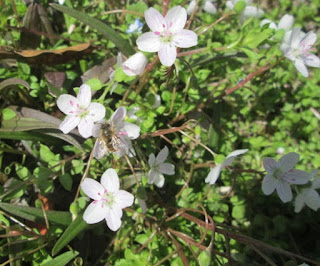This may be the best year for spring beauties (claytonia virginica) that I remember. Of course, it is totally possible that my memory is getting worse, but this year, the little things are everywhere: not only in the lawns and lawn strips where we expect them, but popping up in sidewalk cracks and covering one entire side of the Turtle Mound, a Hopewell earthwork a few blocks from our home. Alas, I had no camera with me when walking past the mound, but this view of a city park may give an idea of the abundance of beauties this year.
And this isn't one of the most thickly- carpeted areas. When the violets and dandelions really get going in a day or so, the show will be even more impressive.
Individual claytonia blooms are small--not as tiny as those of creeping veronica (a favorite weed) but not as large as those of sweet violet, with both of which it shares a blooming season. It is a major nectar source for early pollinators, so most people around here avoid mowing until after the plants go dormant.
Claytonia is edible (not that I have ever sampled it) and has had a variety of medicinal uses. Native peoples dug and roasted the corms, while the raw roots were eaten as a form of birth control. The powdered plant was used to treat convulsions, eye problems, and dandruff, according to Marian Blois Lobstein of the Prince William Wildflower Society.
I don't intend to experiment with our local plant populations, but obviously, spring beauty is more than just a pretty face.



No comments:
Post a Comment